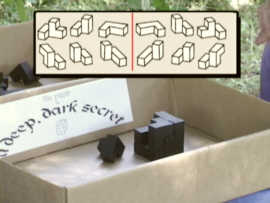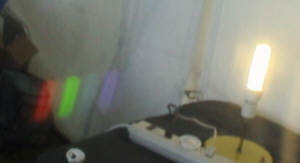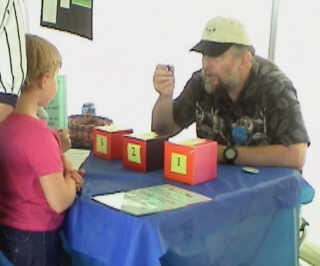 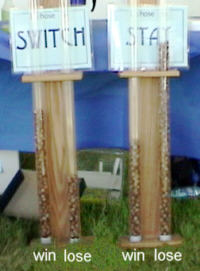
The infamous Monty Hall puzzle in 2004 
Monty Hall, 2003 |
"I'm going to hide this here
little ducky... I might put that little duck in number 3, or I might put
this little duck into number 2. I could put it into number
1. "Which one do you think it's in?"
[Chooses number 1] "Would you put your nut on number 1...Thank you very much. O.K. Now I'm going to give you a chance to change your mind. I going to make it easier by giving you a look in this empty one. "Do you want to switch or stay with your choice? ...hmmm...What to do?" "Stay." "All right, she's going to stay. Is there a duck? I didn't see the duck. That's all right though; you're still a good statistic. You get to put [your result in the tube you chose]" The solution is invisible to some mathematicians! The results of this demonstration rapidly build up as Da Vinci Days procede. It's there for everybody to see, yet remarkably few notice. Statistical things are invisible to a lot of people. Statistics deals with two
phenomena: uncertainty and complex, multiple-factor interaction.
In the past couple of centuries, modern science made huge advances which
opened up these things to human understanding and usefulness. Statistics
is a powerful tool that is seen by far too many people as nothing more
than a tool of liars, cheats, and politicians. It's power remains
invisible.
This year (2004), visitors were frequently given information about the statistical reasoning that underlies this problem. We see a significant increase from 2003 in the percentage that chose "Switch." Nevertheless, a large fraction of participants still do not recognize that the heights of the columns in the tubes constitute information that one choice gives half the probability of winning as does the other choice. Because a very large percentage of scientific information is statistical, scientific literacy requires that we look for and recognize such information. Public education for science is failing at some of its important duties. |
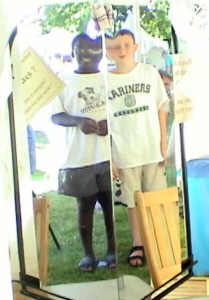 |
The Vampire Mirror
The photographer with his camera is standing between the two boys. So why is he invisible? |
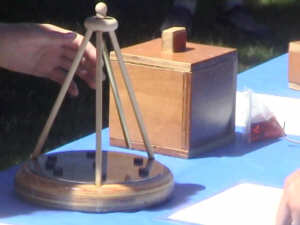 |
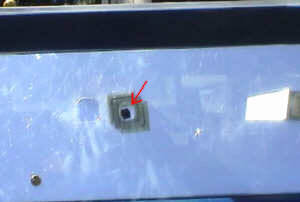
Magnetic fields demonstrations Just what is the invisible magnetic field? |
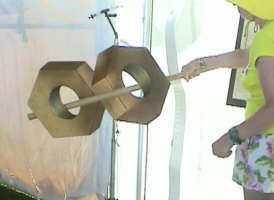 |
The rod is straight. |
 |
Cut a 3 X 5 card and fold it to make this. |
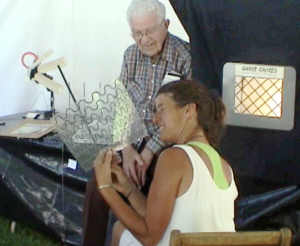 |
Magic of the Mind by Jerry Andrus |
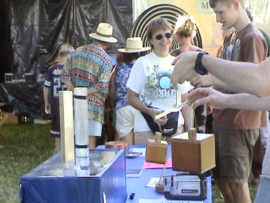 |
Which box feels heavier?
Which box is heavier? |
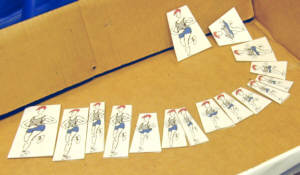 |
Organize the runners.
(It takes two dimensions...and more) This puzzle might seem to be trivial. Far from it! Our love of ranking everything by puting things in a line and looking to where things are positioned with respect to each other is almost always a very serious oversimplification. Correct organization calls for ordering in many dimensions--virtually always. MORE |
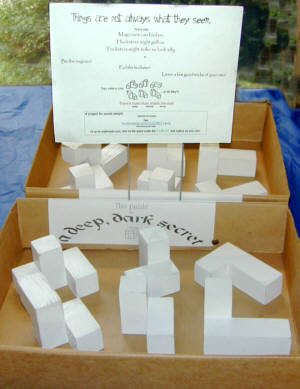 |
Invisible
deception always lurks around us.
Skilled magicians make
the solution disappear.
|
 |
Puzzles galore! |
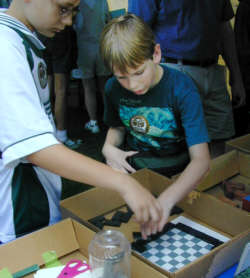 |
And more...
Covering the checkerboard with dominos (or not covering it) demonstrates one of the great, almost invisible, truths of science and mathematics. This puzzle's solution is "elegant." Elegant puzzle solutions are evidence of kinds of knowledge that are a bit different from everyday expereience and having the slightly more abstract nature that makes up most of science and math. Adequate science education must develop a sense of elegant answers. MORE |
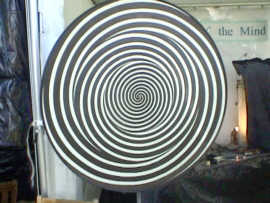 |
Trizonal space-warper.
See the invisible worms under the skin of your hand. |
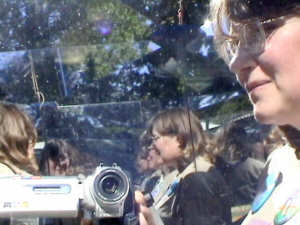 |

Human Kaleidoscope |
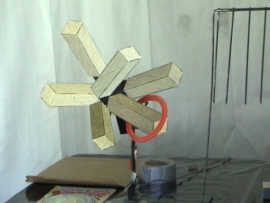 |
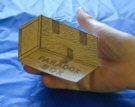 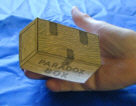
Everybody gets the chance to make some. |
 |
The Paradoilia Canvas.
Visitors
paint abstract patterns.
|
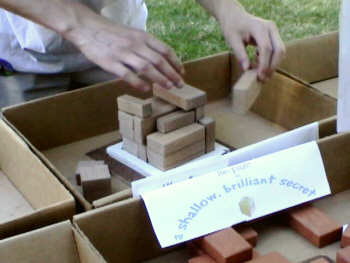 |
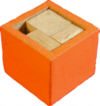
What simple mathematical principle do these two puzzles have in common? LOOK HERE Another elegant solution. If we don't see these solutions, we may convince ourselves we are free to make arbitrary choices and can't be told we are wrong. We can be wrong, and we need to understand why and how. |
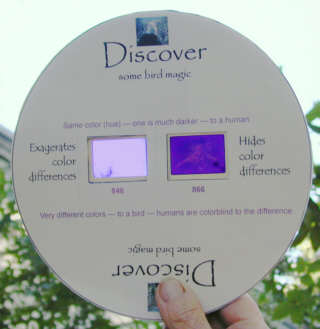 |
 ......... .........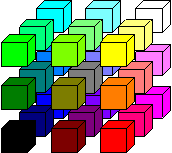 |
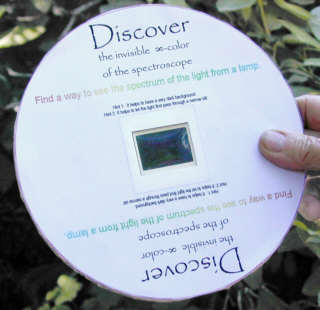 This high-efficiency fluorescent lamp has four bright spectral lines in the visible part of the spectrum as well as s continuous band of visible light |
The spectroscope sees color as would an animal with an infinity of different cones in its eyes--one for each and every wavelength. The spectroscope sees the difference between "line" spectra and "continuous" spectra, a distinction invisible to human eyesight. A lot of science became known when humans found a way to see this bit of the invisible.
|
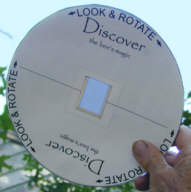 |
The bees view of
the polarized light from the blue sky is invisible to humans. It
tells the bee where the sun is when all the bee sees is a little bit of
blue in a cloudy sky of white.
Here is a simple device by which we can get some of the same information seen by the bee. But we must be cleverer than the bee. We rotate the polarizer until the blue sky is the darkest it gets. The line on the disc then points to the sun. If the sun is 90º away from our line of sight, the darkening is the greatest (the light is maximally polarized). As the angle to the sun is greater or less than 90º the darkening is less. At 180º (and at 0º) there is no darkening (the light isn't polarized). |
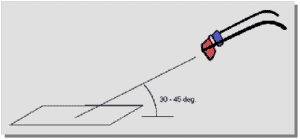
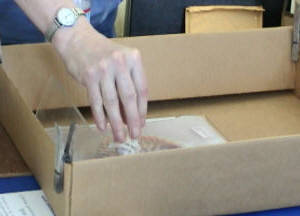
WOW!! |
Phantograms
...and other stereoscopic wonders. Stereoscopic images are often felt to be illusions. But they are no more illusions than are any other photographs. Photographs send to the eye the same messages the eye would receive were it actually at the scene. Stereoscopic photos do the same. In the anaglyph, red and cyan images are printed on paper and received correctly by the right and left eyes because the glasses filter out the inappropriate images. The phantogram stretches the printed anaglyph images out to the rear so that the images are sent to the eyes from a horizontal plane rather than from a photo held the way we usually hold a photo. Stereoscopic objects rise up out of the paper and look startlingly real. MORE
stereo, 2004
Images
furnished by Terry Wilson.
See her Web site: terryfic.com. In Portland, get red-cyan glasses at the 3-D Center. |
 |
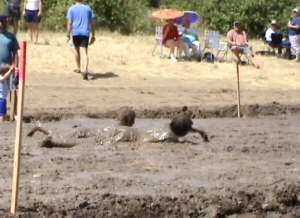
Many observers were willing to get into the mud and help out. |
